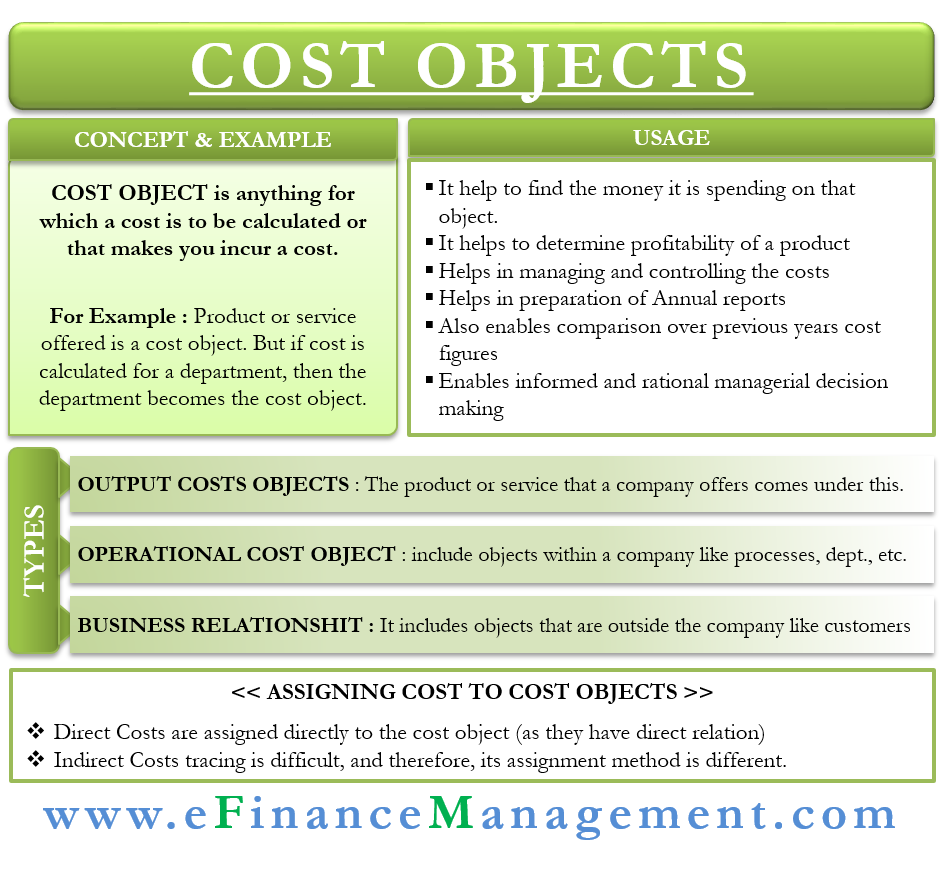A Cost Object is anything for which a cost is to be calculated or that makes you incur a cost. It could be anything for which a company plans to calculate costs separately. A cost object could be a part of the process to come up with the pricing of a product or service. Or, it could be a separate task to find the cost for the cost objects.
For instance, the product or service that a company offers is a cost object. And, if a company wishes to calculate the cost for a project or a department, then the project, customer, or department becomes the cost object. Once a company determines the cost for the project or department, then it may assign its cost to the final product or service to come up with the total cost.
For example, if the sales department is the cost object, then several expenses are traceable to this department. These expenses include salaries to the sales staff, rent for the selling space, stationery costs, marketing costs, and more. A company can then use this cost to set the price of the final product.
Uses of Cost Object
Following are the uses or benefits cost objects:
- Such objects help a company find the money it spends on that object.
- They help in determining the profitability and price of the product or service.
- It also assists a company in managing and controlling costs.
- They also help in the preparation of the annual reports.
- Measuring costs for cost objects at regular intervals can help a company monitor and compare the performance over time.
- They can help make better business decisions, such as when filing a tender, allocating budgets to departments, and more.

Types of Cost Objects
There are primarily three types of cost objects:
Output
The product or service that a company offers comes under this. These are the most common types of cost objects as a company would want to know the cost of its output to set the price.
Also Read: Types of Costs and their Classification
Operational
Operational cost objects include objects within a company for which a company would want to find the cost. These may include process, machine, department, a group of employees, and more.
Business Relationship
It includes objects that are outside the company and for which a company would want to find the cost—for example, the cost of a supplier, customer, or cost of renewing a license, and more.
Assigning Direct and Indirect Costs
Cost objects are a common term in cost and management accounting when allocating direct and indirect costs. One can easily trace direct costs to the cost objects. However, the same may not be right about indirect costs.
Since it is difficult to trace indirect costs, one needs to allocate them to the cost objects. Both direct and indirect costs can be fixed or variable.
Also Read: Types of Costing
Lets’ see how we can assign fixed and variable costs to the cost objects:
- If trousers are the cost object, then the trouser material will be one of the variable direct costs.
- In the above, the salary of the person who stitches the trousers is fixed direct costs.
- The utility costs of the factory area will be the variable or indirect costs in the above example of trousers.
- The insurance of the factory area will be fixed indirect costs.
While assigning a cost to cost object, there are a few things to keep in mind:
- There might be some costs that are so small that the amount and time spent on tracing them could outweigh knowing their cost. Thus, it is better to overlook such costs.
- There are instances where a cost could be a direct cost to one cost object, whereas the same cost becomes indirect for another cost object. For example, if you need to find the cost of the marketing department, then salaries to marketing staff are a direct cost. But, if the product is the cost object, then the salaries will be the indirect cost for that product.
Final Words
Generally, accounting systems are not capable enough to measure the cost of any specific cost object. Thus, a company must regularly scrutinize a few crucial cost objects to check if there is any significant change in the cost or not. Experts recommend carrying an annual review of the cost objects. But, if the cost objects are involved, then a simple single interval review may not be enough. In that case, it has to be done for several intervals.
Read about various other basic Costing Terms.

